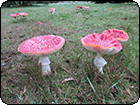 photo by splunge
photo by splunge
 photo by TheophileEscargot
photo by TheophileEscargot
 photo by Kronos_to_Earth
photo by Kronos_to_Earth
 photo by ethylene
photo by ethylene
Comment Feed:
♦ RSS
The linked site might not convey it clearly, but those TWO facts are the content of the great theorem about circles: (1) For ANY three points, there is a circle passing through all three of them, and (2) That circle is unique.